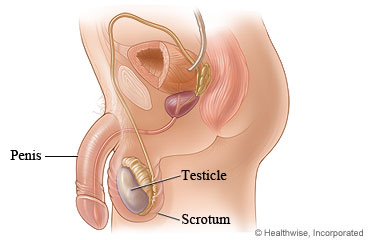Orchiopexy for Testicle Torsion: What to Expect at Home
Your Recovery

You have had an orchiopexy (say "OR-kee-oh-peck-see"). In adults, it
is usually done for testicle torsion. This occurs when your testicle
twists, which twists the cord that provides it with blood. This cuts
off blood from the testicle. It's usually an emergency, and the
surgery takes place right away.
Your doctor made a cut, called an incision, in your scrotum and
untwisted the cord. If the testicle looked like it was too damaged,
your doctor probably removed it. Your doctor may have replaced the
testicle with a prosthetic testicle, which is a plastic oval. This
keeps the shape of your scrotum close to what it was before the
surgery. The loss of one testicle should not change your ability to
get an erection or father a child.
If the testicle is okay, your doctor attached it to your scrotum
with stitches. This will keep the cord from twisting again. Your
doctor also attached the other testicle to the scrotum so the cord
will not twist in the future.
In most cases, doctors use stitches that dissolve on their own in 2
to 3 weeks and don't need to be removed. The incision will ooze
fluid for 2 to 3 days.
You can expect to feel better each day, although you may have some
mild to moderate pain for several days after surgery. You may need
pain medicine during this time. Your scrotum will be swollen after
surgery. This is normal. The swelling usually goes down within 2 to
4 weeks.
You should be able to do most of your normal activities after 1 to 2
weeks, except for those that require a lot of effort. It's important
to avoid straining with bowel movements and doing heavy lifting
while you recover.
This care sheet gives you a general idea about how long it will take
for you to recover. But each person recovers at a different pace.
Follow the steps below to get better as quickly as possible.
How can you care for yourself at home?

Activity
|
|
|
|
|
|
|
|
-
Avoid strenuous activities, such as bicycle riding,
jogging, weight lifting, or aerobic exercise, for 1 to 2
weeks after surgery.
|
|
|
-
Avoid lifting anything that would make you strain. This
may include heavy grocery bags and milk containers, a
heavy briefcase or backpack, cat litter or dog food bags,
a vacuum cleaner, or a child.
|
|
|
|
|
|
|
|
|
|
|
|
|

Diet
|
|
-
You can eat your normal diet. If your stomach is upset,
try bland, low-fat foods like plain rice, broiled chicken,
toast, and yogurt.
|

Medicines

Incision
care

Ice

Other
instructions
Follow-up care is a key part of your treatment and safety. Be
sure to make and go to all appointments, and call your doctor if you
are having problems. It's also a good idea to know your test results
and keep a list of the medicines you take.
When should you call for help?
 Call 911 anytime you think you may need emergency care.
For example, call if:
Call 911 anytime you think you may need emergency care.
For example, call if:
Call your doctor now or seek immediate medical care if:
Watch closely for any changes in your health, and be sure to contact
your doctor if:
Current as of: November 15, 2023
Content Version: 14.0
Care instructions adapted under license by your healthcare professional. If you have questions about a medical condition or this instruction, always ask your healthcare professional. Healthwise, Incorporated disclaims any warranty or liability for your use of this information.